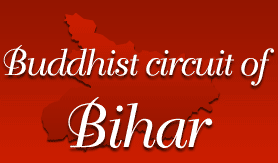|

District - Gaya
Commissionery - Magadh
Headquarter - Gaya
Sub-Division - Gaya Sadar, Sherghati, Tekari
Population - 26, 64,803 (27 Lacs)
Area - 4,941 Sq. Km
Sea Level - 113 Meter
Temperature -
Summer: 46°C - 18°C
Winter: 20°C– 4°C
Best Season - November – February
Road Route - 112 Km from Patna
Rail Route - Main Railway Station –
Patna, Gaya
Nearest Railway Station – Gaya (16 Km),
(458 km from Kolkata; 220 km from Varanasi; 589 km from Puri)
Air Route - Main Airport – Patna
Nearest Airport – Gaya
Main Spots of tourist Interest
Histrocial Importance
Situated on the bank of river Falgu, Gaya
is one of the ancient city in India. In Gaya only Bramhayoni
and Dungeshwari Hills are related to Buddhist Circuit, where
Lord Buddha came before his enlightenment, in search of Nirvana.
Today Gaya is mainly known as for Hindu circuit. Gaya is recognised
as a holy city from ancient period. According to legend, Lord
Vishnu endowed a celestial being named Gaya with the powers
to absolve from sin all those who approached him. The devine
Gaya was also empowered to raise the devout to the heavens
so that they might join their ancestors. On the bank of river
falgu very large number of pilgrims offer Pindan (Funeral
cakes) at the ghats and perform a lengthy circuit of holy
places around Gaya, to free their ancestors from bondage to
the earth.
Places of Tourist Interests
Brahmayoni Mountain
Location: Brahmayoni hill is
situated 1 km south of Vishnupada temple and its description
is found in Buddhist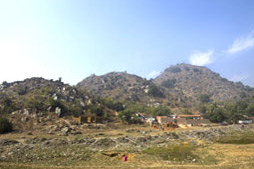 literature. To reach Brahmayoni hill one had to ascend 424
steps.
literature. To reach Brahmayoni hill one had to ascend 424
steps.
Importance: In Brahmyoni Mounain
range there are 3 mountain peaks. Middle mountain peak in
related to Buddhist Circuit & Right side 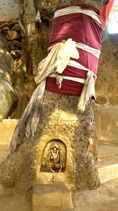 mountain
peak is related to Hindu circuit. mountain
peak is related to Hindu circuit.
Before enlightenment Gautam Buddha spent few days on this
mountain, from this place Buddha reached the Sujata Place
(Now in Bakraur, Bodhgaya) & from this place went to Dungeshwari
Hills & then Bodhgaya to sit under Bodhi tree.
Now on this holy place we can see Ashoka stupa, a huge statue
of Lord Buddha and Holy footprints on the hill. It is believed
that ‘Ashoka the Great’ had got constructed a
stupa here in the memory of Lord Buddha.
There are two interconnected narrow caves on the hill —Brahmayoni
and Matriyoni. There is a belief that if one passes through
the caves he would become free from the cycle of life and
death.
Bihar Government has marked Brahmayoni hill as a ‘protected
monument’. On the middle of peak there is an Ashokastupa
and on its right temple of Brahma temple have been set up.
Dungeshwari Mountain
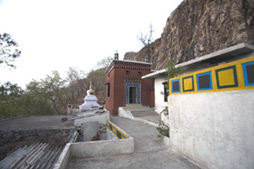
Location: Near to Bakraur (Sujata
Place) on the other bank of falgu river, 32 km from Gaya,
on the Gaya - Jamuawa - Surhari More- road route.
Importance: Lord Buddha came
here from Sujata Place. On this place ‘devine powers’
suggested him to go to Bodhgaya for enlightenment. This mountain
was known as ancient 'Pragbodhi mountain'.
On the top of the mountain there are 7 ruins of Ashoka stupa.
In the middle of the mountain, there is a Buddhist Temple
& Hindu Temple, attract large no. of tourist on this holy
place.
Rock-Cut-Sculptures
of Kauvadol Hills
Location: Kauvadol Hills in
32 km far from Gaya District Headquarter, 20 km from Bela
& 6 km from south-west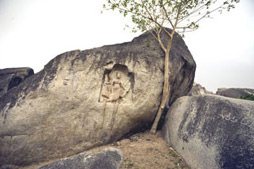 Barabar caves (Jehanabad). Kauva Dol Hills is situated about
a mile south-west of Barabar Hills, situated north-east of
Belaganj block.
Barabar caves (Jehanabad). Kauva Dol Hills is situated about
a mile south-west of Barabar Hills, situated north-east of
Belaganj block.
Importance: From the mound here
remains of an ancient temple have been found. From the base
of Kauadol mountain a large number of stone idols of Hindu
god and goddess have been found. A ‘Gaumukhi Shivalinga’,
a ‘Bansha bull’ considered to be carrier of Lord
Shiva, has been found from the base of the mountain near tomb
of Pir. It is believed that Kauadol (Kurisarai) was a town
of Northern Gupta period (6-7th century BC) and it was named
as Shramanpur. Chinese traveller 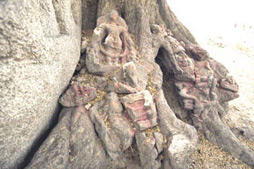 Hieun-Tsang
had mentioned ‘Shilbhadra Mahavihar’ which is
believed to be at this place only. ASI-Branch-3, Patna team
has expressed hope that here remains of Northern Gupta period
to mid-term might be found. Hieun-Tsang
had mentioned ‘Shilbhadra Mahavihar’ which is
believed to be at this place only. ASI-Branch-3, Patna team
has expressed hope that here remains of Northern Gupta period
to mid-term might be found.
On the rocks of the northern and eastern face of Kauva Dol
Hill, numberous figures representing mostly Hindu deities
like Hara-Gauri, Mahishasuramarddini Durga, Ganesa etc. A
few figures of the seated Buddha are also noticed viz of Vajrasattva,
Prajnaparamita and a seated Buddha. The sculptures may be
assigned to a period between 800 to 1200 A.D. At Barabar Hills
the passage leading to the Holy ‘Siddheshwarnath temple’
are ancient rock cut sculptures or Shiva Linga, Shiva Parvati,
Ganesha etc. The image of the goddess Durga are how ever largest
in number at Kauva Dol Hills. the four armed Durga slaying
the buffalo demon Mahishasura. Other Brahmanical Figures are
also noticed.
Ruins of Buddhist Monastery Hills
Base & Buddhist Temple
Location: Kauvadol Hills in
30 km far from Gaya District Headquarter, 20 km from Bela
& 6 km from south-west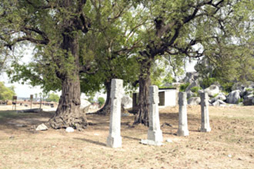 Barabar caves (Jehanabad). Kauodol is situated north-east
of Belaganj block. Ruins of Buddhist Monastery is situated
in the base of Kauva Dol Hills which is situated about a mile
south-west of Barabar Hills.
Barabar caves (Jehanabad). Kauodol is situated north-east
of Belaganj block. Ruins of Buddhist Monastery is situated
in the base of Kauva Dol Hills which is situated about a mile
south-west of Barabar Hills.
Importance: It is considered
important for its archaeological finds. In the 4th century
BC it was a ‘training centre’ for young Buddhist
monks, who were called ‘Shamner’. During that
period this was training centre for not only Magadh area but
for whole central area. In the 4th century BC Sramanpur was
a township.
At the base of the Kauadol hill archaeological remains can
still be found. According to historian Wenglar, the place
was sanctum sanctorum of the temple — where one mandap,
a semi-mandap and a maha-mandap existed. Till 1902 here 13
mandap existed and now only 9-10 mandap could be seen. Kauva
Dol has been identified as the site of the ancient ‘monastery
of Silbhadra’. This place was visited by Hiuen-Tsang
in the 7th century. The Bodhisattva touched the earth when
Mara challenged him. Exhorting the Earth goddess to appear
to witness his enlightenment. Following excavation by the
ASI and Bihar ASI, an eight-feet statue of Lord Buddha could
be found in ‘Bhoomisparsh’ (ground-touching) posture.
Buddhist Temple – Near Buddhist
Monastery, Kauvadol
Location: Kauvadol Hills in
32 km far from Gaya District Headquarter, 20 km from Bela
& 6 km from south-west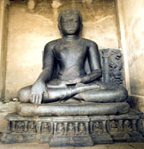 Barabar caves (Jehanabad). Kauodol is situated north-east
of Belaganj block and the base of Kauadol hill. Buddha Temple
is situated in the base of Kauva Dol Hills which is situated
about a mile south-west of Barabar Hills
Barabar caves (Jehanabad). Kauodol is situated north-east
of Belaganj block and the base of Kauadol hill. Buddha Temple
is situated in the base of Kauva Dol Hills which is situated
about a mile south-west of Barabar Hills
Importance: The colossal image
of Lord Buddha in Bhumi-sparsamudra is of Silbhadra monastery.
Silbhadra was a learned Buddhist of the royal family of Samatata.
This is one of the largest satues of Buddha extant and is
in fair preservation except that a portion of the halo has
been broken the figure is about 8 feet high with a breadth
of 4 feet across the shoulders and 6 feet across the knees.
Ruins of Buddist Monestery, Top
of Kauvadol Hills
Location: Kauvadol Hills in
32 km far from Gaya District Headquarter, 20 km from Bela
& 6 km from south-west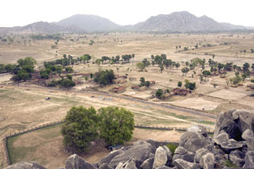 Barabar caves (Jehanabad). Kauodol is situated north-east
of Belaganj block. Ruins of Buddhist Monastery is situated
on top of Kauva Dol Hills which is situated about a mile south-west
of Barabar Hills
Barabar caves (Jehanabad). Kauodol is situated north-east
of Belaganj block. Ruins of Buddhist Monastery is situated
on top of Kauva Dol Hills which is situated about a mile south-west
of Barabar Hills
Importance: Beside one of the
mountain hills of Kauvadol, on the top, there is ruins of
Buddhist monastery. Several stones pillars, parts of doorway
are seen hither & thither on the top of hill & near
to top.
Gaya Museum
Location: Situated in the heart
of the town of Gandhi Maidan, Gaya.
Importance: The museum has been
declared as Gaya Museum-cum-Magadh Cultural Centre with a
view to collect, display and make available all the relevant
information regarding living cultural heritage of the region
under one roof.
The museum preserves about 2000 antiquities of varied nature.
The rich collection of stone sculptures especially of Pala
period is rare and outstanding. Besides, the Museum also possesses
a good collection of coins of different periods (punch marked
to medieval period coins), manuscripts, terracotta figurines
ranging right from Mauryan to the Gupta period, Pala bronzes
and other art objects. Among the important antiquities mention
may be made of Visnu, danching Ganesha, Tara, Surya in stone,
replica of Mahabodhi temple in bronze and Aa-ne-Akabari. The
special attractions here are monuments of Pala period (750-1120
BC).
Besides these, there are coins of ancient times till Mughal
era, old manuscripts, monuments from Mauryan to Gupta period,
stone and bronze statues at the Gaya Musuem.
The museum was established in 1952 by a local lawyer Baldev
Prasad, and was later acquired by the Bihar government and
opened for public viewing on February 14, 1970.
|
